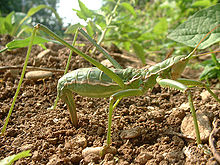Big saw bug
| Big saw bug | ||||||||||||
|---|---|---|---|---|---|---|---|---|---|---|---|---|

A large sawhopper in the Croatian part of the Istrian peninsula laying eggs |
||||||||||||
| Systematics | ||||||||||||
|
||||||||||||
| Scientific name | ||||||||||||
| Saga pedo | ||||||||||||
| ( Pallas , 1771) |
The great sawhorse ( Saga pedo ) is a predatory species of long-feeler terrors and is one of the largest and at the same time rarest insects in Europe.
Occurrence
Mediterranean countries , southern Central Europe (also in the Valais ), Alpine countries south of the main Alpine ridge, Southeastern Europe, the Near and Middle East to Kazakhstan .
Ecology and appearance
Until July 14, 2005, only females of the great hawk were observed. According to previous knowledge, the species only reproduces parthenogenetically : the unfertilized eggs hatch almost exclusively to females that are 7–9 centimeters long. Then there is the laying tube, which measures 30–35 millimeters after the last, the sixth moult . The basic color is green, often a light band runs along the sides of the body from the eye to the tip of the abdomen. The front and middle legs and rails are thorn-reinforced at the bottom. With them the prey animals are seized and held. The females have a 30–35 mm long, laterally flattened and slightly upwardly curved laying tube (ovipositor) with which the approximately 2 × 11 mm measuring, brown eggs are deposited individually or in small groups in the soil, mostly in the roots of grasses become. Depending on the weather, there are around 50-100 eggs in total. After two winters at the earliest, often later, the larvae (nymphs) hatch from the eggs in early May. They already resemble adult animals, but the laying tube is still barely visible. Head-torso length and antennae length are each about 15 mm after hatching.
The sawhorses inhabit bush and grasslands, mostly on calcareous soils. They live predatory and mainly prey on other grasshoppers and crickets, which are grabbed with the front and middle pairs of legs and pressed against the thorny chest. Even adult females of the European praying mantis ( Mantis religiosa ) are overwhelmed.
On July 14, 2005 a male was observed and photographed for the first time near Martigny (CH / Wallis), probably for the first time. It then disappeared undetectably in the vegetation, but was observed and photographed again on July 31, 2005. Due to the typical drawing for the species, it was clearly identified as a male of the Saga pedo saw-hedge . In Switzerland there is no other of the 13 saga species that A. Kaltenbach recognized as clearly distinguishable in 1967. The newly discovered male is apparently the first male documented in the literature to date. In all other sawhorse species, males are just as common as females and no parthenogenesis is known.
literature
- Bertrand & Hannes Baur, Christian & Daniel Roesti: The locusts of Switzerland . Haupt Verlag, Bern 2006, ISBN 3-258-07053-9 .
Web links
- Saga pedo inthe IUCN 2013 Red List of Threatened Species . Listed by: Orthopteroid Specialist Group, 1996. Retrieved November 26, 2013.
- Saga pedo at Orthoptera.ch



